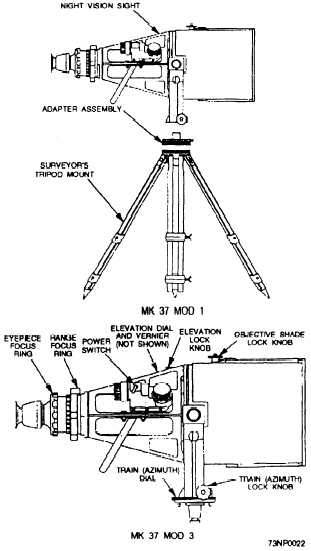Prevent dust from getting on the lenses as much
as possible. Always leave the optics in their cases, or
covered, when not in use. When dust gathers on the
lenses, clean them only with lens paper, and make sure
that your supply of lens paper is kept clean. Don't
clean a lens when it doesn't need it. Repeatedly
cleaning a lens, no matter how skillfully you do it,
eventually damages the lens. Strong sunlight discolors
the cement, and excessive heat often softens cemented
lenses and filters and may allow them to separate.
Moisture in any form, whether salt spray or the
perspiration from your hand, causes film and chemical
deterioration of the optical glass.
To have a useful piece of optical equipment when
you need it, follow these few simple rules:
Handle your optical equipment carefully. Don't
let it bang against another object.
When the optical equipment is not in use, keep
it stowed in its proper place.
Keep it dry and out of the weather.
Keep it clean; use only appropriate material to
clean it.
Don't hang optical devices over the side, and
when you are using binoculars, always keep
them on a strap around your neck.
Don't attempt to repair optical equipment. Send
it to a repair ship or tender where Opticalmen
have the proper equipment to make repairs.
NIGHT VISION DEVICES
LEARNING OBJECTIVE: Explain procedures
for operating, maintaining, and cleaning night
vision devices.
Night vision devices belong to a family of
precision instruments that use electronic optics for
observation, surveillance, and navigation. Night
vision sights (NVSs) can be used in conjunction with
the IR equipment discussed previously in this chapter.
Night vision devices are used to scan an area
accurately and to detect enemy movement, to observe
friendly forces, or to accomplish various other tasks
associated with night devices.
Normally, night vision devices will be operated on
ships from the signal bridge and bridge level. As a
Signalman, you will be required to maintain and
operate night vision equipment.
This section will acquaint you with the principles
of operation, maintenance, and safety precautions for
night vision devices.
MK 37 NIGHT VISION SIGHT
The Mk 37 Mod 1 and Mod 3 NVS (fig. 2-16) are
passive sights that emit no visible or IR light. An
image intensifier tube is used to amplify received
light, thus enhancing or allowing vision under
nighttime or similar conditions of low illumination.
The primary function of the Mk 37 NVS is long-range
observation, such as enemy surveillance and target
detection.
Figure 2-16.—Mk 37 Mod 1 and Mod 3 night vision sights.
2-14

